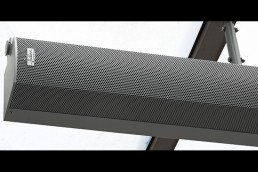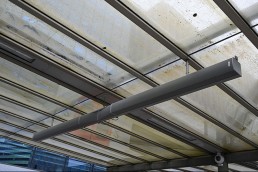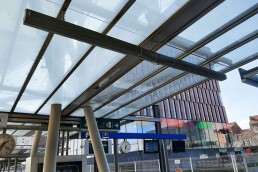This website uses cookies so that we can provide you with the best user experience possible. Cookie information is stored in your browser and performs functions such as recognising you when you return to our website and helping our team to understand which sections of the website you find most interesting and useful.
Leuven Railway Station
ProjectLeuven Railway StationLocationLeuven, BelgiumManufacturersArbane GroupeInstallerTVV Sound ProjectAcousticianEric Grandmougin, FranceSubmitted byArbane Groupe
Originally constructed in the 1830s, Leuven station’s design dates back to 1875, when it was rebuilt in the eclectic style. Since 2000, it has undergone a series of renovations, including the addition of a monumental roof comprising 16 sloping white domes, designed by Philippe Samyn and Partners to resemble sails fluttering in the wind, with 13 railway lines underneath serving national and international destinations.
System integrator TVV Sound Project was contracted by Infrabel, the Belgian public railway operator, to overhaul the previous 20-year-old PA system. “Most of Leuven station’s platforms are covered by a large, high arched canopy, while some are covered by a low, flat roof,” confirms Edo Dijkstra, CEO of TVV Sound. “The renovation included the replacement of the existing loudspeakers under these canopies, both high and low. Architecturally, nothing was allowed to change the lay-out of the existing loudspeakers.”
The new system, centred on StepArray SA180S column loudspeakers, is capable of delivering crystal-clear public announcements, along with ambient background music, to the more than 8 million passengers annually who pass through the station – one of Belgium’s busiest.
The complex acoustic environment created by the station’s mix of architectural styles, as well as restrictions on how the loudspeakers could be installed, presented the main challenges for Active Audio and TVV Sound, according to Arbane Groupe’s Eric Grandmougin, who defined the system’s specifications after modelling the acoustics of the station.
Grandmougin explains that the design of the SA180S – which provides a 15m SPL of 97dB in a slimline 1,840mm × 124mm package – allowed his team to experiment with installing the loudspeakers horizontally, enabling them to work around the restrictions inherent in the space.
“This new way of using Active Audio column loudspeakers was first tested and validated internally, before being integrated into an electroacoustic model of the station to predict the system’s overall performance,” he comments. “The results obtained were in line with the operator’s requirements, and validation listening sessions were carried out in Belgium at our distributor, TVV Sound. This project enabled us to validate the performance of the SA108S in a horizontal position, as well as the homogeneity of the directivity.”
Leuven station marks the largest deployment to date of Active Audio’s StepArray SA180S column loudspeakers, with 64 of the intelligent, steerable devices providing ultimate intelligibility as part of the unique sound system deployment.
In Leuven, the StepArray columns, in addition to being mounted in a previously untested horizontal orientation, were coupled together in pairs (32 × 2 SA180S), helping TVV Sound to work around the space constraints while still being able to adjust the speakers’ directivity – an essential aspect of the final installation.
“It was only with a beam steering system that we were able to achieve perfect sound reproduction,” explains Edo Dijkstra, referring to the DGRC (Digital & Geometric Radiation Control) steering technology built in to the StepArray series, which was key to combatting the acoustic reflections produced by the station’s concrete and glass structure. DGRC uses a patented arrangement of speakers that reduces the number of amplifiers necessary to drive the loudspeaker system while still ensuring excellent directivity.
“Active Audio’s StepArray loudspeakers are renowned for their optimal intelligibility and acoustic comfort,” he adds, “and unique because of their controlled directivity. They are also the only company whose products can guarantee the horizontal beam steering we needed for the Leuven project.”
Tom De Bie from Infrabel says the company is “very satisfied” with the new sound system, which has been painted to match the station’s existing colour scheme. “The clarity of the audio provided to travellers has improved considerably,” he comments.
Beyond the performance of the StepArray speakers, the Leuven project demonstrated the ability of Arbane Groupe to respond to the specific demands of a large-scale installation. “Indeed, the horizontal use of the columns required mechanical adjustments to the loudspeakers in order to allow easy installation of the system,” adds Eric Grandmougin, “taking into account the specifics of railway stations, which are not very simple places in terms of integration.”




